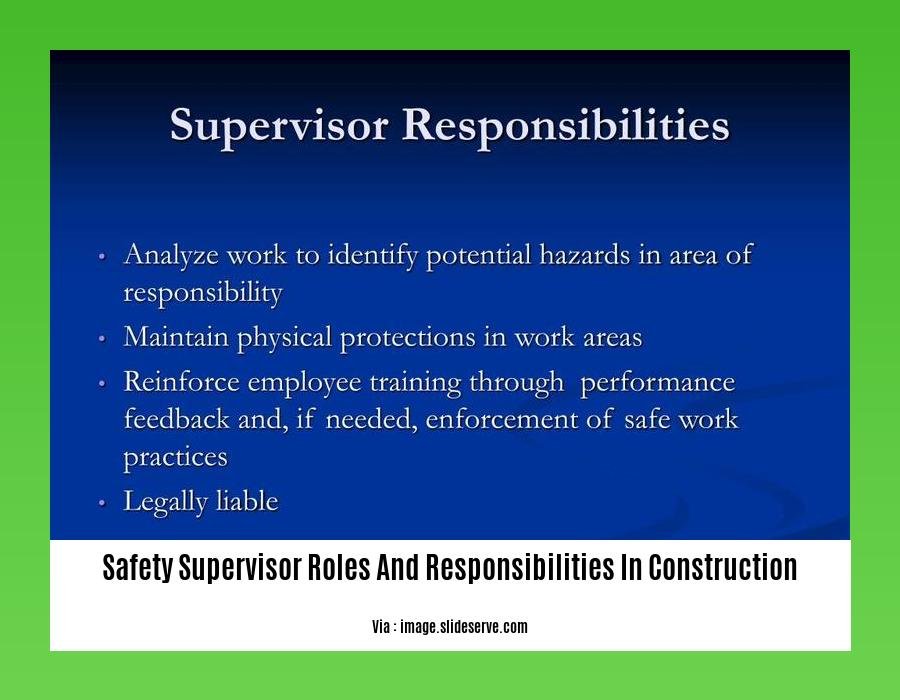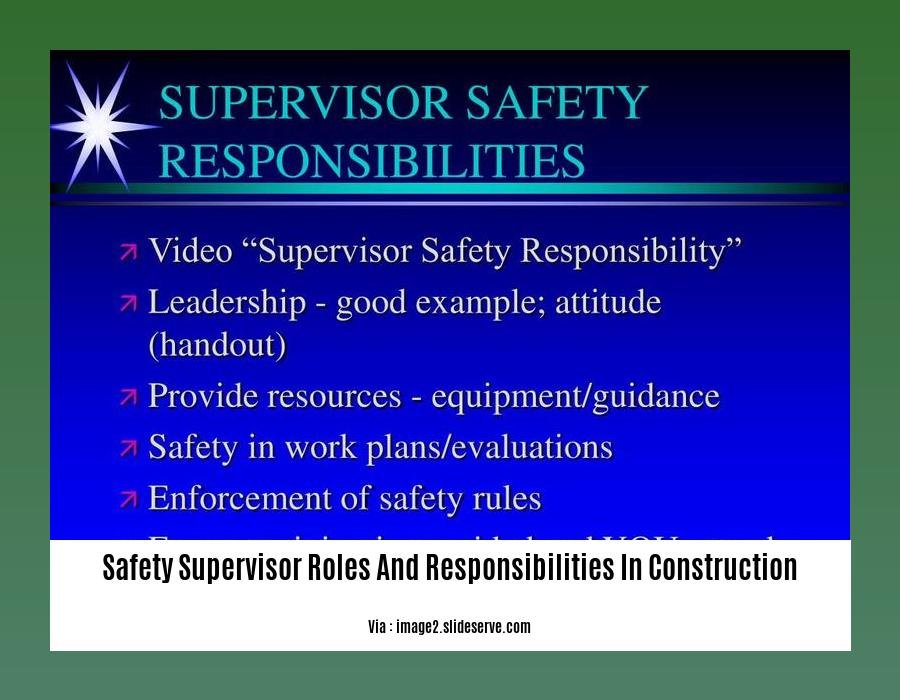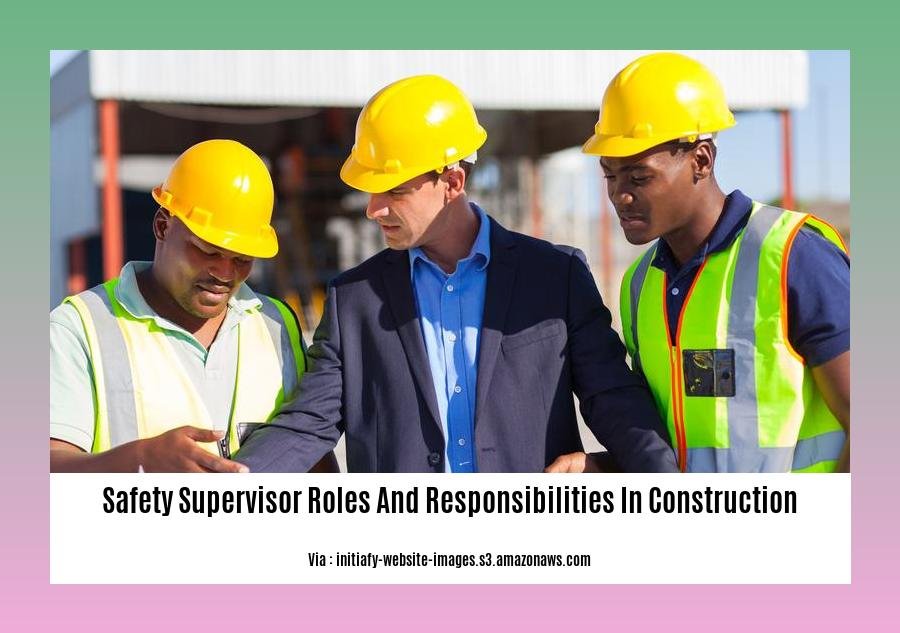– Safety Supervisor Roles and Responsibilities in Construction: A Comprehensive Guide to Enhancing Workplace Safety –
Key Takeaways:
- Conduct thorough safety inspections to identify and eliminate hazards.
- Train workers on safety protocols and enforce compliance.
- Collaborate with contractors and subcontractors to foster a safe work environment.
- Supervise and instruct construction team and subcontractors.
- Enforce site safety rules to prevent accidents and injuries.
- Schedule and coordinate construction activities to ensure safety.
- Inspect subcontractor work to meet quality standards.
- Maintain a clean and safe job site by adhering to regulations.
Safety Supervisor Roles and Responsibilities in Construction: A Comprehensive Guide

Throughout history, the construction industry has been known for being fraught with hazards and risks. Consequently, the role of safety supervisors is paramount in ensuring the well-being of construction workers and the overall success of construction projects. These individuals are responsible for implementing and enforcing safety measures, promoting a culture of safety awareness, and minimizing the likelihood of accidents and injuries on construction sites.
In this article, we delve into the essential roles and responsibilities of safety supervisors in construction, providing a comprehensive guide to their critical tasks and the overall impact they have on workplace safety.
Key Responsibilities of Safety Supervisors in Construction
- Site Safety Inspections: Regularly inspect construction sites to identify potential hazards such as unsafe work practices, hazardous materials, and defective equipment.
- Hazard Assessment and Risk Management: Assess risks associated with construction activities, develop mitigation plans, and implement control measures to minimize the likelihood of accidents and injuries.
- Safety Training and Education: Train workers on safety regulations, proper safety procedures, and emergency response protocols.
- Enforcement of Safety Standards: Enforce compliance with established safety standards, regulations, and company policies to ensure a safe work environment for all personnel.
- Accident Investigation and Reporting: Investigate workplace accidents and incidents, determine root causes, and recommend corrective actions to prevent future occurrences.
- First Aid and Emergency Response: Provide first aid and coordinate emergency medical services in case of injuries or illnesses.
- Incident Reporting and Recordkeeping: Maintain accurate records of safety inspections, accidents, and incidents to facilitate trend analysis and continuous improvement.
Benefits of Effective Safety Supervision
- Reduced workplace accidents and injuries
- Improved worker morale and productivity
- Enhanced compliance with safety regulations
- Reduced insurance premiums
- Positive impact on company reputation
Conclusion
Safety supervisors play a vital role in the construction industry, ensuring the well-being of workers and the success of construction projects. Their expertise in safety management, risk assessment, and compliance ensures a safe and productive work environment for all personnel. By understanding the roles and responsibilities of safety supervisors in construction, we can appreciate their contributions to workplace safety and the overall success of construction projects.
To ensure the highest level of safety on your construction site, refer to our comprehensive guide on safety standards in the construction industry.
For an effective presentation of your construction company’s capabilities, download our professionally crafted sample construction company profile PDF.
Plan and manage your construction projects efficiently with our downloadable sample construction schedule in MS Project.
Train and Educate Workers on Safety Procedures

Key Takeaways:
- Conduct comprehensive safety training for new and existing employees to ensure safety awareness.
- Develop and implement clear safety protocols and procedures for workers to follow.
- Empower employees to report unsafe conditions without fear of reprisal.
- Provide workers and managers with a clear understanding of the safety and health program.
- Conduct regular safety inspections and risk assessments to identify and mitigate hazards.
Steps to Train and Educate Workers on Safety Procedures:
-
Identify Safety Training Needs: Determine the specific safety knowledge and skills your workers require based on their job responsibilities and the hazards present in the workplace.
-
Develop Training Materials: Create engaging and comprehensive training materials that cover all relevant safety topics, including hazard recognition, safe work practices, emergency procedures, and the use of personal protective equipment (PPE).
-
Deliver Safety Training: Conduct training sessions in a clear and engaging manner, using a variety of methods such as presentations, discussions, hands-on demonstrations, and written materials.
-
Evaluate Training Effectiveness: After training, assess workers’ understanding of the safety procedures through quizzes, practical exercises, or observations.
-
Provide Ongoing Safety Education: Regularly refresh workers’ safety knowledge with toolbox talks, safety bulletins, and reminder posters.
By effectively training and educating workers on safety procedures, you can ensure they have the knowledge and skills to work safely, reducing the risk of accidents and injuries.
Resources:
- The duties and responsibilities of safety supervisors in achieving an effective safety performance
- 20 Key Roles and Responsibilities Of Safety Supervisors
Monitor and Enforce Compliance with Safety Standards
As a safety supervisor, ensuring compliance with safety standards is paramount. Here’s how to do it effectively:
1. Conduct Regular Inspections:
Meticulously inspect the workplace for potential hazards, unsafe conditions, and non-compliant practices.
2. Train and Educate Workers:
Provide comprehensive training on safety standards, procedures, and proper use of equipment. Ensure workers understand the importance of compliance.
3. Enforce Consequences:
Establish clear consequences for non-compliance, including warnings, suspensions, or terminations. Enforce these consequences fairly and consistently.
4. Foster a Safety Culture:
Promote a culture where safety is valued and everyone is responsible for reporting hazards and unsafe behaviors.
5. Seek Continuous Improvement:
Regularly review safety procedures and make improvements based on identified hazards and best practices.
Key Takeaways:
- Conduct thorough workplace inspections
- Train workers on safety standards
- Enforce consequences for non-compliance
- Foster a safety-conscious culture
- Continuously improve safety procedures
Sources:
- OSHA: Safety and Health Management
- HSE: Enforcing Health and Safety
Collaborate with Contractors and Workers to Promote Safety Culture
As a safety supervisor, fostering a collaborative safety culture is crucial. Here’s how:
-
Establish Clear Communication Channels: Regular safety meetings, toolbox talks, and open communication channels encourage open dialogue about safety concerns, best practices, and updates.
-
Empower Employees to Report Hazards: Create an environment where workers feel comfortable reporting unsafe conditions or practices without fear of retaliation.
-
Involve Contractors in Safety Planning: Collaborate with contractors and workers throughout the project lifecycle to ensure all parties understand and align on safety protocols.
-
Foster a Learning Environment: Provide ongoing safety training and education to all employees to keep them up-to-date on safety regulations and best practices.
-
Recognize and Reward Positive Safety Behavior: Acknowledge and reward individuals and teams who demonstrate exceptional safety performance.
By building a collaborative safety culture, you create an environment where everyone feels accountable for their safety and the safety of others.
Key Takeaways:
- Establish clear communication channels
- Empower employees to report hazards
- Involve contractors in safety planning
- Foster a learning environment
- Recognize and reward positive safety behavior
Relevant URL Sources:
- HSE Blog: Responsibilities of Safety Supervisors
- HSSE World: The Duties and Responsibilities of Safety Supervisors
FAQ
Q1: What are the primary safety concerns in construction?
A1: Construction sites pose various safety hazards, including falls from heights, electrocution, equipment-related accidents, trench collapses, and exposure to hazardous materials.
Q2: What is the role of a safety supervisor in construction?
A2: A safety supervisor is responsible for ensuring a safe and healthy work environment by conducting safety inspections, providing training, enforcing safety protocols, and investigating incidents.
Q3: What are the responsibilities of a safety supervisor in construction?
A3: Key responsibilities include enforcing safety policies, conducting risk assessments, providing training, investigating accidents, and identifying and reporting system weaknesses.
Q4: What are the qualifications of a safety supervisor in construction?
A4: A safety supervisor typically requires a combination of education (e.g., a degree in occupational safety or engineering), certification (e.g., OSHA 30), and experience in the construction industry.
Q5: How can a safety supervisor promote a culture of safety in construction?
A5: By engaging workers in safety discussions, providing ongoing training, recognizing safety efforts, and being visible and approachable on the construction site.
- Modern Backsplash Ideas: A Guide to Todays Kitchen Trends - December 18, 2025
- Ceramic Kitchen Wall Tiles: Style and Protection for Your Walls - December 17, 2025
- Kitchen tiling wall: Elevate your kitchen with stylish wall tiles - December 16, 2025









